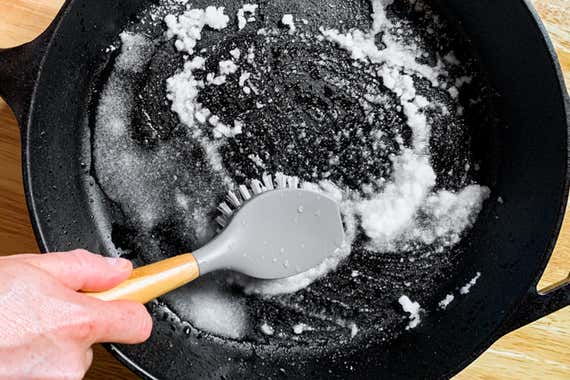Cast iron cookware is cherished by many for its durability, heat retention, and natural non-stick surface. However, cleaning it can be a bit tricky. If not done properly, you risk removing the precious seasoning you’ve worked hard to build. In this guide, we will explore how to clean cast iron without removing seasoning. Follow these tips to keep your cast iron in excellent condition for years to come.

Why Seasoning is Important
The seasoning on a cast iron skillet is a layer of polymerized oil that provides a non-stick surface and protects the iron from rust. It’s built up over time through the process of cooking with oil and fat. Properly seasoned cast iron turns cooking into an enjoyable experience.

Basic Cleaning Steps
Step 1: Let the Pan Cool
Before you start cleaning, allow your cast iron pan to cool down. Washing a hot pan can cause thermal shock, potentially causing it to warp.
Step 2: Use a Non-Metal Scrubber
To avoid removing seasoning, use a non-metal scrubber such as a sponge or brush with soft bristles. Avoid using steel wool or abrasive scrubbers that can scrape off the seasoning.
Step 3: Rinse with Warm Water
Rinse the pan under warm water without using soap. Soap can strip away the seasoning youve worked so hard to build. If food remains stuck, use a small amount of coarse salt as a gentle abrasive.
Step 4: Dry Thoroughly
After rinsing, dry the pan thoroughly with a towel to avoid rust. You can also place it on the stovetop over low heat for a few minutes to make sure it’s completely dry.
Step 5: Apply a Thin Layer of Oil
Once the pan is dry, apply a thin layer of vegetable oil to the surface and store it in a dry place. This helps maintain the seasoning and protects the iron.

Cleaning Stubborn Residue
For stubborn, stuck-on food, use a paste made from kosher salt and a bit of water. Scrub the residue gently using this paste and a non-metal scrubber, then rinse and dry thoroughly.

Do’s and Don’ts of Cast Iron Care
Don’t: Soak in Water
Soaking cast iron in water can cause rust and degrade the seasoning. Always avoid prolonged contact with water.
Don’t: Use Dish Soap
Dish soap can break down the oils in the seasoning layer. Stick to water and, when necessary, salt or baking soda.
Do: Re-season Periodically
If you find that your cast iron skillet’s seasoning is deteriorating, it’s essential to re-season it. This involves coating the pan with a layer of oil and baking it in the oven at high temperatures. You can learn more details on re-seasoning cast iron skillet.
Caring for Your Cast Iron in the Long Term
Regular Use
Regular use of your cast iron pan actually helps maintain its seasoning. The more you cook with it, especially when using fats and oils, the better the seasoning becomes.
Proper Storage
Store your cast iron in a dry place to avoid rust. Placing a paper towel inside the pan can help absorb any moisture during storage.
Restoring a Rusty Cast Iron Pan
If you encounter rust, don’t panic. Scrub the rust off with a non-metal scrubber and re-season the pan immediately. Check out our detailed step-by-step guide on how to restore and re-season cast iron.
Frequently Asked Questions
Is it okay to use soap on cast iron?
No, using soap can remove the seasoning. Stick to warm water and non-abrasive scrubbing.
How often should I re-season my cast iron pan?
Periodically, depending on use. If food starts to stick or the surface appears dull, it’s time to re-season.
Can I use metal utensils with cast iron?
While metal utensils can be used, they can scratch the seasoning. It’s best to use wooden or silicone utensils.
Conclusion
Cleaning cast iron without removing its seasoning may seem challenging initially, but with these tips, you can maintain your cookwares excellent condition. Remember, regular cleaning and proper care will keep your cast iron skillet performing exceptionally for years.
As an Amazon Associate, I earn from qualifying purchases.

